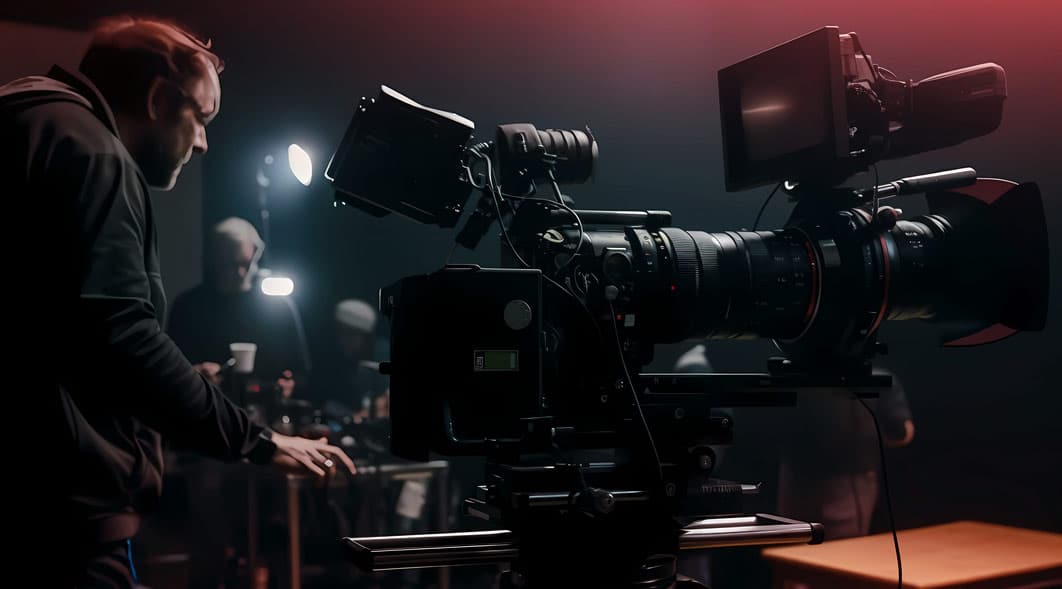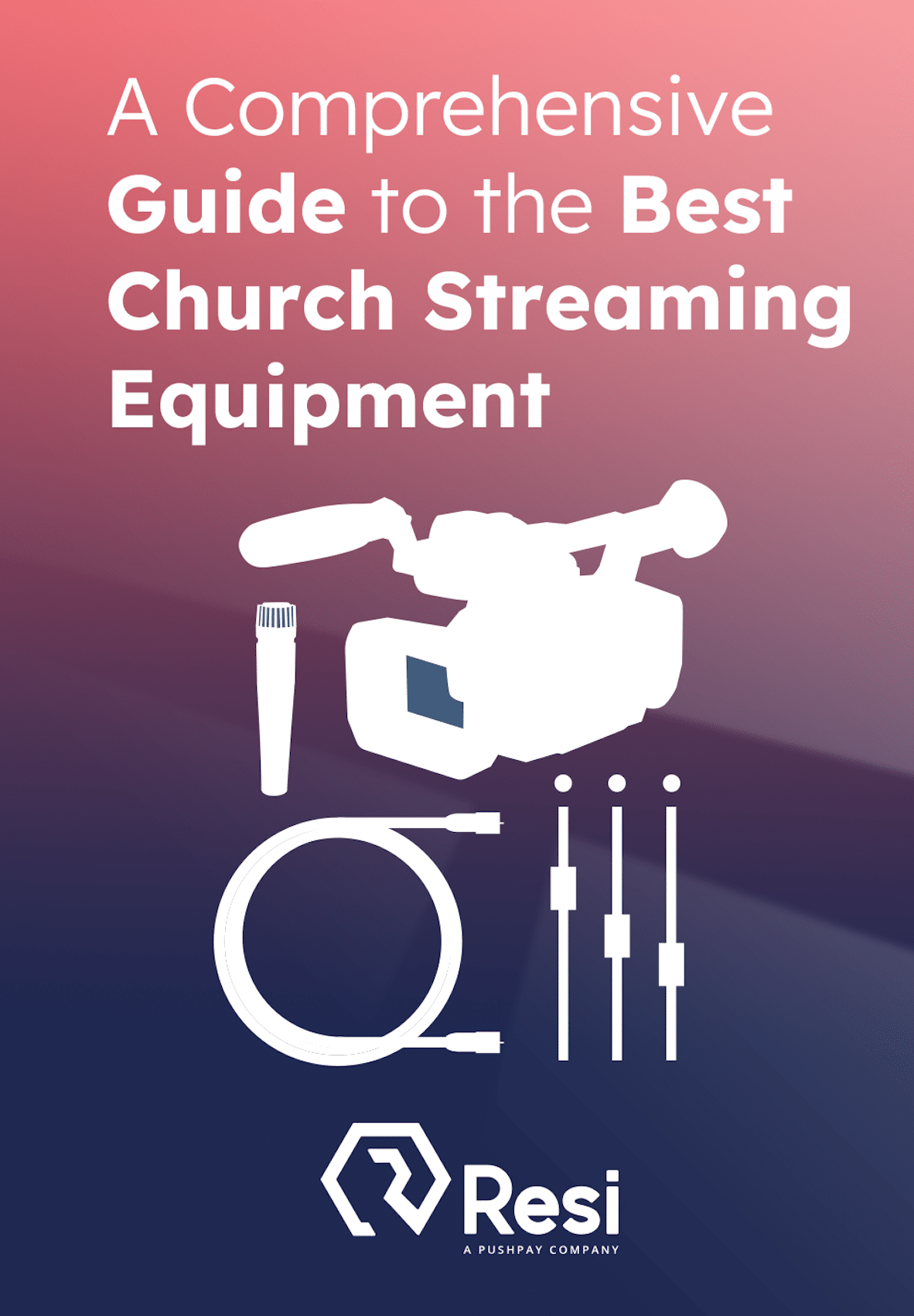
The rise of live streaming has made multi-camera setups essential for connecting with our congregations. This blog will walk you through setting up and optimizing a multi-camera system that enhances both in-person and online worship experiences.
We’ll cover practical aspects like camera positioning, lighting, and audio integration, while also addressing common pitfalls that can disrupt the worship experience. But throughout, we’ll stay focused on the ultimate goal: ensuring that everything we do, from technical to spiritual, points people to the redeeming love of Christ.
Best Livestreaming Equipment
Discover what top-rated equipment we recommend adding to your church streaming toolkit.
Download for free!
Importance of a Multi-Camera Setup
The Role of Multiple Cameras
Multiple cameras enable dynamic storytelling. Just as a compelling story draws people in, a well-captured service can engage viewers in the narrative of the worship experience. Different camera angles allow us to present the service in a way that captures, and retains, the attention of your online congregation. Whether it’s a dynamic shot of the in-house congregation, a hand held camera getting a close up of your worship team, or the standard shot of the pastor as they’re teaching, these visuals tell the story of a church alive in Christ.
How It Improves Engagement
Engagement is about more than keeping attention; it’s about connecting people to the core of the worship experience. A multi-camera setup enhances engagement by providing varied perspectives that immerse the viewer in the service as if they were in the room. For online viewers, these angles can make the experience feel more personal, immediate, and real.
It’s not only about the technology but about how we use it to serve the Kingdom. By thoughtfully using a multi-camera setup, we can help create worship experiences that draw people deeper into the truth and beauty of the Gospel, whether they’re with us in person or joining us from a distance.
Selecting the Right Cameras
Key Considerations When Choosing Cameras
When selecting cameras for your church’s multi-camera setup, it’s essential to start with a solid foundation. The cameras you choose will directly affect the visual quality of your worship service, both for those in the sanctuary and those joining online. Here are some key considerations to guide your decision:
Camera Resolution and Image Quality: Viewers today expect high-definition content, and anything less can detract from the worship experience. HD (1080p) should be your minimum standard, but if the budget allows, investing in 4K cameras can future-proof your setup and provide an exceptionally sharp and immersive visual experience. The clarity of the image can either enhance or distract from the message being shared. A crisp, clear picture helps viewers focus on what truly matters—the worship and the Word.
Budget vs. Quality: It’s tempting to think that higher cost always means better quality, but that’s not necessarily the case. Finding the right balance between budget and quality is key. Consider what’s most important for your specific needs—do you need multiple high-end cameras, or would a mix of quality and quantity better serve your congregation? Wise stewardship means making decisions that maximize the resources God has entrusted to you. Sometimes, investing in a few high-quality cameras that are versatile and reliable is better than spreading your budget too thin across multiple lower-quality options.
Compatibility with Existing Equipment and Streaming Software: Before purchasing any cameras, consider how they will integrate with your existing setup. Are they compatible with your current equipment—such as your switcher, encoders, and streaming software? Ensuring compatibility will save time, money, and frustration later on. It’s worth consulting with a technical expert or someone experienced in this area to make sure everything will work together seamlessly.
Optimal Camera Placement and Angles
Understanding the Layout of Your Worship Space
One of the most critical aspects of a successful multi-camera setup is understanding the layout of your worship space. Your sanctuary, like every other part of your ministry, has been designed with intention, and your camera placement should reflect that. The goal is to capture the essence of your worship service in a way that is both meaningful and engaging, whether someone is sitting in the pews or watching from home.
Identifying Key Focal Points: Start by identifying the key focal points of your worship space. These typically include the altar, the podium or pulpit, the choir, and the congregation. These are the areas where the most significant moments of worship, preaching, and congregational participation occur. Your camera placement should prioritize these focal points, ensuring they are always in view and captured in the best possible way.
Placing Cameras to Capture Both Wide Shots and Close-Ups: To create a dynamic visual experience, it’s important to have a mix of wide shots and close-ups. Wide shots provide a sense of the entire space and the collective worship experience, while close-ups focus on specific details—like the pastor’s expression or hands raised in worship. Placing cameras strategically around the worship space allows you to switch between these perspectives, enhancing the overall impact of the service.
Best Practices for Camera Angles
Once you’ve mapped out your worship space and identified the key focal points, the next step is to determine the best camera angles. The angles you choose will influence both the visual storytelling and how connected your audience feels to the service.
The Importance of a Main Camera for Consistent Framing: The main camera serves as your anchor, providing a consistent, stable view of the service. Typically placed at the back of the sanctuary and facing the altar or podium, it should be positioned at eye level or slightly above to capture the speaker or worship leader in a way that feels natural. Consistent framing from the main camera helps maintain continuity throughout the service, grounding the viewer in the space.
Utilizing Side and Back Angles to Add Depth and Variety: In addition to the main camera, side and back angles can add depth and variety to your broadcast. Side angles, positioned at approximately 45 degrees to the podium or stage, can capture more intimate moments, such as the interaction between the preacher and the congregation or the choir’s performance. Back angles offer a unique perspective of the congregation, showing the collective response to the worship and message. These angles help create a more immersive experience for the viewer, making them feel as though they are part of the gathering.
How to Avoid Obstructed Views and Maintain a Clear Line of Sight: A common challenge in camera placement is avoiding obstructed views. Ensure your cameras are positioned to minimize the risk of being blocked by people or objects. For example, placing cameras on elevated platforms or using PTZ cameras mounted on walls can help maintain a clear line of sight. It’s also important to consider the movement of people during the service—whether it’s the pastor walking across the stage or the congregation standing for worship—and adjust your camera angles accordingly to avoid any disruptions in the broadcast.
By carefully considering the layout of your worship space and the placement of your cameras, you can create a multi-camera setup that effectively captures the service and enhances the worship experience for everyone involved. Whether through wide, sweeping shots that convey the grandeur of the space or intimate close-ups that capture the emotion of the moment, thoughtful camera placement and angles will ensure that your worship service is seen, heard, and felt in a way that honors God and uplifts His people.
Best Livestreaming Equipment
Discover what top-rated equipment we recommend adding to your church streaming toolkit.
Download for free!
Integrating Lighting and Audio
The Relationship Between Lighting and Camera Performance
In any worship service, the way your cameras capture the moment is deeply influenced by the quality of the lighting. Lighting is more than just an aesthetic choice; it’s a critical component that directly affects how your audience experiences the service. Proper lighting can transform a good video into an exceptional one, bringing out the details and emotions that make your worship service resonate with viewers.
How Proper Lighting Enhances Video Quality: Cameras rely on light to capture images, and the amount and type of light can significantly impact the clarity and color accuracy of your footage. Well-placed lighting can highlight the key areas of your worship space, ensuring that the focus remains on what’s most important—whether it’s the pastor delivering a message, the worship leader guiding the congregation in song, or the expressions of those engaged in worship. Proper lighting enhances the contrast and depth of your video, making it more visually appealing and easier for viewers to connect with.
Common Lighting Mistakes and How to Avoid Them: Lighting can be tricky, and there are some common pitfalls to avoid. One of the most frequent mistakes is backlighting—when a light source is placed behind the subject, it can cause the subject to appear as a silhouette, making it difficult for viewers to see facial expressions and details. Another mistake is uneven lighting, where some parts of the stage or worship space are too bright while others are too dark. This can create a distracting and unbalanced visual experience. To avoid these issues, ensure that your lighting is consistent and that it illuminates the subjects from the front or sides, avoiding harsh shadows and creating a warm, welcoming atmosphere.
Audio Synchronization
While visuals are important, audio is what truly carries the message. Poor audio quality can undermine even the best video production, making it hard for viewers to stay engaged. Ensuring that your audio is clear and perfectly synchronized with your video is essential for creating a seamless and immersive worship experience.
Importance of Syncing Audio with Video for a Seamless Experience: Audio and video must work together in harmony. If the audio is out of sync—whether it’s delayed or too fast—it can be jarring for the viewer, pulling them out of the worship experience. Synchronization is especially critical in live streaming, where even a slight delay can become noticeable. Using software or hardware that ensures your audio and video are in sync is crucial. Regular testing and adjustments are key to maintaining this synchronization throughout the service.
Tips for Capturing Clear Audio from Different Parts of the Worship Space: Worship spaces can be acoustically challenging, with sounds coming from various directions—whether it’s the pastor at the podium, the choir in the loft, or the congregation in the pews. To capture clear audio, consider using a combination of microphones strategically placed around the worship space. Directional microphones can help isolate specific sounds, such as the speaker’s voice, while ambient microphones can capture the collective sound of the congregation. It’s important to balance these audio sources so that the final mix is clear, natural, and free of distractions like background noise or feedback.
Choosing the Right Microphones and Sound Equipment for Multi-Camera Setups: The type of microphones and sound equipment you choose will have a significant impact on your audio quality. Lapel microphones are excellent for capturing the pastor’s voice without being obtrusive, while shotgun microphones can be used to focus on specific areas, like the choir or a soloist. For capturing the ambient sound of the congregation, omnidirectional microphones are ideal. Additionally, investing in a quality audio mixer and digital audio interface will allow you to blend these different sources effectively and ensure that the audio feed is crisp and synchronized with the video.
Integrating lighting and audio effectively requires attention to detail and a commitment to excellence, but the results are well worth the effort. When done right, these elements work together to create a worship experience that is not only seen and heard but felt—drawing people closer to God and deepening their connection to the community of faith. Whether your congregation is gathered in person or joining from afar, a well-lit and clearly heard service can make all the difference in how they experience the presence of God in your worship.
Streamlining Production and Switching Between Cameras
The Role of a Video Switcher
The video switcher is the core of your multi-camera setup—it’s the tool that allows you to create a seamless and polished live stream by switching between different camera feeds in real-time. The switcher’s role is to ensure that your audience experiences the service as a cohesive narrative, where each camera angle is chosen with purpose, enhancing the flow of worship rather than distracting from it.
How a Switcher Works to Create a Polished Live Stream: A video switcher lets you choose which camera feed goes live at any given moment. It’s not just about toggling between angles; it’s about crafting a visual story that aligns with the emotional and spiritual arc of the service. A good switcher will enable smooth transitions between different cameras, add overlays like scripture or lyrics, and even incorporate pre-recorded videos or graphics. Using a switcher helps you create a professional-quality broadcast that keeps viewers engaged and focused on the worship experience.
Choosing the Right Video Switcher for Your Needs: When selecting a video switcher, consider the complexity of your service and the number of cameras you’ll be using. Entry-level switchers are suitable for smaller setups with just a few cameras, while more advanced switchers can handle multiple inputs, video effects, and even live streaming directly. Choose a switcher that not only meets your current needs but also offers room for growth as your production capabilities expand. Look for a switcher that is user-friendly, especially if volunteers will be operating it, and one that integrates well with your existing equipment.
Best Practices for Live Switching
Operating a video switcher during a live service requires a blend of technical skill and an intuitive sense of timing. The goal is to switch between cameras in a way that complements the flow of the service, drawing attention to key moments without overwhelming the viewer with constant changes.
Timing Camera Changes to the Flow of the Service: Effective live switching requires a deep understanding of the rhythm of your worship service. Timing is crucial—switching cameras at the right moment can highlight a powerful sermon point, capture an emotional moment in worship, or provide a broader view of the congregation’s response. Anticipate these moments and be ready to switch cameras in a way that enhances the viewer’s connection to what’s happening in the service. Avoid switching too frequently, as this can be distracting, but don’t hesitate to change angles when it adds to the storytelling.
Balancing Between Static Shots and Dynamic Movements: A well-produced live stream strikes a balance between static shots and dynamic movements. Static shots provide stability and allow viewers to focus on the message, while dynamic movements—like panning or zooming—can add energy and engagement, especially during worship or dramatic moments. Use dynamic movements sparingly and intentionally, ensuring they serve the overall worship experience rather than distract from it.
Training Volunteers to Operate the Switcher Effectively: Many churches rely on volunteers to run their AV equipment, including the video switcher. Providing thorough training is essential to ensure that your volunteers feel confident and capable in their roles. Start by teaching them the basics of how the switcher works, then move on to more advanced techniques like timing transitions and selecting the best camera angles. Encourage them to practice during rehearsals or less critical services, and provide ongoing support and feedback to help them improve. Remember, the goal is not just technical proficiency but also cultivating a sense of ministry in their work—helping them understand how their role contributes to the overall worship experience.
By streamlining your production and mastering the art of switching between cameras, you can elevate the quality of your live stream, making it a powerful tool for ministry. A well-executed broadcast doesn’t just look good; it draws people in, helping them feel connected to the service and, ultimately, to the message of the Gospel. With the right tools, training, and a heart for excellence, your church’s multi-camera setup can become a means of sharing God’s love and truth with a wider audience than ever before.
Best Livestreaming Equipment
Discover what top-rated equipment we recommend adding to your church streaming toolkit.
Download for free!
Common Mistakes to Avoid
Excellence in live streaming and multi-camera production is about more than just having the right tools; it’s about using them effectively. To ensure your broadcast not only looks good but also serves its intended purpose, it’s important to be aware of common mistakes that can hinder your efforts. Here’s how to avoid them:
Operational Errors
Overusing Certain Angles or Shots: While consistency is important, over-relying on the same camera angles or shots can make your stream feel monotonous. Viewers may start to lose interest if they’re seeing the same perspective for too long, particularly during extended portions of the service. To keep the broadcast engaging, mix up your camera angles regularly. Alternate between wide shots, close-ups, and dynamic movements to create a visually varied experience. However, be mindful not to switch too rapidly, as this can be just as distracting as staying on one angle for too long.
Neglecting the Online Audience by Focusing Too Much on the In-Person Experience: It’s easy to get caught up in the energy of the in-person worship experience, but it’s important not to neglect your online audience. Remember, they’re not just passive viewers; they’re part of your congregation, even if they’re joining from a distance. Ensure that your camera angles, audio mix, and overall production are optimized for those watching online. This might mean incorporating more close-ups or paying extra attention to audio clarity, so the online audience feels just as connected as those in the room.
Practical Solutions
Regular Equipment Checks and Maintenance: Consistent maintenance is key to avoiding technical pitfalls. Make it a priority to schedule regular check-ups for all your AV equipment, including cameras, microphones, switchers, and streaming software. Keep a log of any issues that arise, so you can track patterns and address recurring problems before they affect your service. This preventative approach ensures that your gear remains in good working condition and reduces the likelihood of unexpected failures.
Consistent Training for the Production Team: Your production team is at the heart of your live stream’s success. Regular training sessions can help ensure that everyone on the team is confident in their roles and familiar with the latest best practices. Whether it’s learning how to operate new equipment, understanding the nuances of live switching, or troubleshooting common issues, ongoing education is essential. Encourage your team to view their work as a ministry, recognizing that their technical skills are a vital part of how the church communicates the Gospel.
By being aware of these common mistakes and implementing practical solutions, you can create a live stream that is both technically sound and spiritually impactful. When your multi-camera setup is running smoothly, it allows the focus to remain where it should be—on the message of hope and redemption that your church is sharing with the world. Through careful planning, regular maintenance, and thoughtful production, your church can continue to reach people, both near and far, with the life-changing message of the Gospel.
Future-Proofing Your Multi-Camera Setup
Scalability and Upgradability
As your church grows and technology evolves, so should your multi-camera setup. Future-proofing your system is about more than just keeping up with the latest gadgets; it’s about ensuring that your equipment and processes can scale with your ministry’s needs.
How to Plan for Future Growth and Technology Changes: When investing in new equipment or upgrading your current setup, think long-term. Consider the growth of your congregation, the expansion of your online audience, and the potential need for additional cameras or more sophisticated streaming capabilities. Choose equipment that not only meets your current needs but also has the capacity to handle future demands. For instance, opting for 4K cameras might seem unnecessary now if you’re streaming in HD, but as more platforms and viewers transition to higher resolutions, having 4K capabilities will keep you ahead of the curve.
The Importance of Choosing Versatile Equipment That Can Adapt to New Needs: Versatility is key when future-proofing your setup. Look for equipment that is modular and upgradeable—cameras that can be enhanced with additional lenses or mounts, switchers that can handle more inputs as you add cameras, and streaming software that offers regular updates and new features. By choosing versatile equipment, you ensure that your setup can evolve with your church’s needs, rather than requiring a complete overhaul every few years.
Staying Updated with Trends
Technology and media trends are constantly shifting, and staying informed is crucial to maintaining a relevant and effective multi-camera setup.
Monitoring Industry Trends to Keep Your Setup Current: Regularly monitor trends in live streaming, video production, and church technology. This could include attending conferences, following industry blogs, or connecting with other churches to share insights and experiences. Staying updated with trends helps you anticipate changes and adapt your setup accordingly, ensuring that your church remains at the forefront of effective ministry through technology.
Investing in Continuous Learning for Your Production Team: Your production team is the backbone of your live streaming efforts, and their knowledge and skills need to grow alongside technological advancements. Invest in continuous learning opportunities, such as workshops, online courses, or cross-training within your team. Encourage them to experiment with new techniques and stay curious about emerging tools. A well-trained team not only keeps your setup running smoothly but also brings fresh ideas and creativity to your broadcasts, making your services more engaging and impactful.
Conclusion
Following best practices for your multi-camera setup is essential for creating a worship experience that is both visually engaging and spiritually enriching. From selecting the right cameras and optimizing placement to integrating lighting and audio and streamlining production, every detail matters in crafting a service that connects with both in-person and online audiences.
Next Steps: If you’re looking to take your church’s live streaming and multi-camera setup to the next level, explore the solutions offered by Resi.io. Whether you’re just starting out or looking to scale your production, Resi.io provides the tools and support needed to deliver high-quality, reliable streams that keep your congregation connected and engaged, wherever they are. Start your journey toward a more effective and impactful online ministry today.







